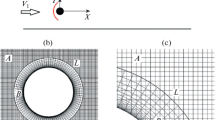Abstract
A clear understanding of the mechanism responsible for large amplitude shock pulsations ahead of a hemispherical cavity in supersonic flow is presented for the first time in this article. This has applications in supersonic parachute decelerators during the atmospheric descent stage of aerospace vehicles. A cell-centered finite volume code FaSTAR is used to solve the full Navier–Stokes equations on a hemispherical shell facing a Mach 4.0 supersonic free stream. The numerical method is validated against earlier experimental results. First, Flow Configuration A appears consisting of an axisymmetric shock that undergoes low-amplitude oscillations. This flow transitions to Flow Configuration B that has an asymmetric shock structure and undergoes large-amplitude non-stationary shock pulsations. The shock stand-off distance in Flow Configuration B is 1.65 times that in Flow Configuration A. The generation of vortices from the curved shock, amplification of vortices of one kind due to the dynamics of the cavity flow, and further interaction of these amplified vortices with the shock in a loop causes the large-amplitude shock pulsations. The oscillation frequencies as determined from cavity pressure and shock stand-off distance signals extracted from the unsteady results are 1.26 kHz during Flow Configuration A, and 859 and 863 Hz during the non-stationary pulsations of Flow Configuration B. The Helmholtz resonator model predicts quite accurately the frequency of Flow Configuration A (1.27 kHz), and to a good extent the frequency in Flow Configuration B (916.7 Hz).









Similar content being viewed by others
References
Bendura, R.J., Lundstvom, R.R., Renfroe, P.G., LeCroy, S.R.: Flight tests of the Viking parachute system II—parachute results. NASA technical report TN D-7737 (1974)
Cruz, J.R., Mineck, R.E., Keller, D.F., Bobskill, M. V.: Wind tunnel testing of various disk-gap-band parachutes. In: (AIAA-2003-2129), 17th AIAA Aerodynamic Decelerator Systems Technology Conference and Seminar, Monterey, California (2003)
Charczenko, N.: Wind-tunnel investigation of drag and stability of parachutes at supersonic speeds. NASA technical report TM X-991 (1964)
Heinrich, H.G.: Aerodynamics of the supersonic guide surface parachute. J. Aircraft 3(2), 105–111 (1966)
Roberts, B.G.: An Experimental study of the drag of rigid models representing two parachute designs at M = 1.40 and 2.19. Aeronautical Research Council Report C.P. No. 565 (1960)
Karagiozis, K., Kamakoti, R., Cirak, F., Pantano, C.: A computational study of supersonic disk-gap-band parachutes using large-eddy simulation coupled to a structural membrane. J. Fluids Struct. 27, 175–192 (2011)
Sengupta, A., Wernet, M., Roeder, J., Kelsch, R., Witkowski, A., Jones, T.: Supersonic testing of 0.8 m disk gap band parachutes in the wake of a 70 deg sphere cone entry vehicle. In: (AIAA 2009–2974), 20th AIAA Aerodynamic Decelerator Systems Technology Conference and Seminar, Seattle, Washington (2009)
Xue, X., Koyama, H., Nakamura, Y., Wen, C.: Effects of suspension line on flow field around a supersonic parachute. Aerosp. Sci. Technol. 43, 63–70 (2015)
Sengupta, A.: Fluid structure interaction of parachutes in supersonic planetary entry. In: (AIAA 2011-2541), 21st AIAA Aerodynamic Decelerator Systems Technology Conference and Seminar, Dublin, Ireland (2011)
Kawamura, T., Mizukaki, T.: Aerodynamic vibrations caused by a vortex ahead of hemisphere in supersonic flow. In: (Paper No. 2565) 28th International Symposium on Shock Waves (ISSW-28), Manchester, UK (2011)
Mizukaki, T., Hatanaka, K., Saito, T.: Large deformation of bow shock waves ahead of a forward-facing hemisphere. In: (Paper No. 0246–000147), 29th International Symposium on Shock Waves (ISSW-29), Wisconsin, Madison (2013)
Hashimoto, A., Murakami, K., Aoyama, T., Ishiko, K., Hishida, M., Sakashita, M., Lahur, P.R.: Toward the fastest unstructured CFD code FaSTAR. In: (AIAA 2012–1075), 50th AIAA Aerospace Sciences Meeting including the New Horizons Forum and Aerospace Exposition, Nashville, Tennessee (2012)
Hashimoto, A., Murayama, M., Yamamoto, K., Aoyama, T., Tanaka, K.: Turbulent flow solver validation of FaSTAR and UPACS. In: (AIAA 2014–0240), 52nd Aerospace Sciences Meeting, National Harbor, Maryland (2014)
Engblom, W.A., Goldstein, D.: Fluid dynamics of unsteady cavity flow. Technical report, US Army Research Laboratory, IAT.R 0121 (1996)
Haibo, L., Weiqiang, L.: Investigation of thermal protection system by forward-facing cavity and opposing jet combinatorial configuration. Chin. J. Aeronaut. 26(2), 287–293 (2013)
Silton, S.I., Goldstein, D.B.: Use of an axial nose-tip cavity for delaying ablation onset in hypersonic flow. J. Fluid Mech. 528, 297–321 (2005)
McGilvray, M., Jacobs, P.A., Morgan, R.G., Gollan R.J., Jacobs C.M.: Helmholtz resonance of pitot pressure measurements in impulsive hypersonic test facilities. In: (AIAA 2009–1157), 47th AIAA Aerospace Sciences Meeting Including The New Horizons Forum and Aerospace Exposition, Orlando, Florida (2009)
Ladoon, D.W., Schneider, S.P., Schmisseur, J.D.: Physics of resonance in a supersonic forward-facing cavity. J. Spacecr. Rockets 35(5), 626–632 (1998)
Engblom, W., Goldstein, D.: Acoustic analogy for oscillations induced by supersonic flow over a forward-facing nose cavity. In: (AIAA 2009–0384) 47th AIAA Aerospace Sciences Meeting Including The New Horizons Forum and Aerospace Exposition, Orlando, Florida (2009)
Hashimoto, A., Murakami, K., Aoyama, T., Lahur, P.R.: Lift and drag prediction using automatic hexahedra grid generation method. In: (AIAA 2009–1365), 47th AIAA Aerospace Sciences Meeting Including The New Horizons Forum and Aerospace Exposition, Orlando, Florida (2009)
Ben-Dor, G.: Two dimensional interactions—oblique shock reflections. In: Ben-Dor, G., Igra, O., Elperin, T. (eds.) Handbook of Shock Waves, vol. 2, pp. 68–204. Academic Press, London (2001)
Argyropoulos, C.D., Markatos, N.C.: Recent advances on numerical modelling of turbulent flows. Appl. Math. Model. 39(2), 693–732 (2015)
Acknowledgments
The authors would like to thank JAXA, Japan, for the access to their CFD codes FaSTAR and HexaGrid.
Author information
Authors and Affiliations
Corresponding author
Additional information
Communicated by F. Lu and A. Higgins.
Rights and permissions
About this article
Cite this article
Hatanaka, K., Rao, S.M.V., Saito, T. et al. Numerical investigations on shock oscillations ahead of a hemispherical shell in supersonic flow. Shock Waves 26, 299–310 (2016). https://doi.org/10.1007/s00193-015-0613-0
Received:
Revised:
Accepted:
Published:
Issue Date:
DOI: https://doi.org/10.1007/s00193-015-0613-0




